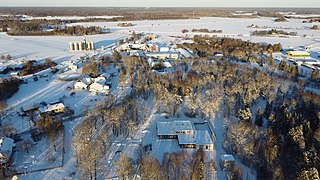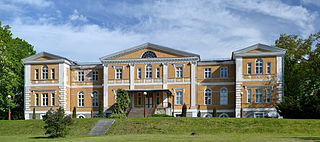
The history of Latvia began around 9000 BC with the end of the last glacial period in northern Europe. Ancient Baltic peoples arrived in the area during the second millennium BC, and four distinct tribal realms in Latvia's territory were identifiable towards the end of the first millennium AD. Latvia's principal river Daugava, was at the head of an important trade route from the Baltic region through Russia into southern Europe and the Middle East that was used by the Vikings and later Nordic and German traders.

Baltic Germans are ethnic German inhabitants of the eastern shores of the Baltic Sea, in what today are Estonia and Latvia. Since their resettlement in 1945 after the end of World War II, Baltic Germans have markedly declined as a geographically determined ethnic group in the region.
Eminent domain, land acquisition, compulsory purchase, resumption, resumption/compulsory acquisition, or expropriation is the power of a state, provincial, or national government to take private property for public use. It does not include the power to take and transfer ownership of private property from one property owner to another private property owner without a valid public purpose. This power can be legislatively delegated by the state to municipalities, government subdivisions, or even to private persons or corporations, when they are authorized by the legislature to exercise the functions of public character.
Land reform in Zimbabwe officially began in 1980 with the signing of the Lancaster House Agreement, to reverse the distribution of land that resulted from the colonial occupation of the country by white people. The colonial distribution that started in 1884, took land from black people, land the black people called home and used for habitation and production as subsistence farmers. The colonisers drove black people to dry and unproductive land while they shared prime and productive land amongst themselves resulting in a population of 3% owning 51% of the land while 4.3 million black people owned 42%, with the remainder being land for towns and other non-farming activities. The white people enjoyed superior political and economic status, but this was resisted, leading to war, and political independence in 1980. At independence, the Lancaster House Agreement was signed and it had a clause that prohibitted return of land, except where a white person had surrendered or offered it for sale. This did not return enough land until the accelerated land reform programme started in 2000. The programme altered the racial imbalance of land ownership.

The Bessarabia Germans were a German ethnic group who lived in Bessarabia between 1814 and 1940.

Baltic German nobility was a privileged social class in the territories of today's Estonia and Latvia. It existed continuously since the Northern Crusades and the medieval foundation of Terra Mariana. Most of the nobility were Baltic Germans, but with the changing political landscape over the centuries, Polish, Swedish and Russian families also became part of the nobility, just as Baltic German families re-settled in locations such as the Swedish and Russian Empires. The nobility of Lithuania is for historical, social and ethnic reasons separated from the German-dominated nobility of Estonia and Latvia.

Alavere is a village in Anija Parish, Harju County in northern Estonia. The population was 345 in 2019.
Four major land reforms have taken place in Romania: in 1864, 1921, 1945 and 1991. The first sought to undo the feudal structure that had persisted after the unification of the Danubian Principalities in 1859; the second, more drastic reform, tried to resolve lingering peasant discontent and create social harmony after the upheaval of World War I and extensive territorial expansion; the third, imposed by a mainly Communist government, did away with the remaining influence of the landed aristocracy but was itself soon undone by collectivisation, which the fourth then unravelled, leading to almost universal private ownership of land today.

Kuremaa is a small borough in Jõgeva Parish, Jõgeva County in eastern Estonia. It lies 10 km from Jõgeva, near the northern shore of Lake Kuremaa, the 11th largest lake in Estonia. Kuremaa features an estate that was owned by the von Oettingen family until the early 20th century. Part of the estate's manor house is now a museum, its windmill in neighbouring Mooritsa village is a popular landmark, and its terraced gardens reach down to the shore of Lake Kuremaa.

Land reform is an important political and economic topic in Namibia. It consists of two different strategies: resettlement, and transfer of commercially viable agricultural land. Resettlement is aimed at improving the lives of displaced or dispossessed previously disadvantaged Namibians. Farms obtained by government for resettlement purposes are usually split into several sections, and dozens of families are being resettled on what had previously been one farm. Transfer of commercial agricultural land is not directly conducted by government. Would-be farmers with a previously disadvantaged background obtain farms privately or through affirmative action loans. In both cases, the "Willing buyer, willing seller" principle applies.

The Estonian Soviet Socialist Republic, Soviet Estonia, or simply Estonia, was a union republic of the Soviet Union (USSR), covering the occupied and annexed territory of Estonia in 1940–1941 and 1944–1991. The Estonian SSR was nominally established to replace the until then independent Republic of Estonia on 21 July 1940, a month after the 16–17 June 1940 Soviet military invasion and occupation of the country during World War II. After the installation of a Stalinist government which, backed by the occupying Soviet Red Army, declared Estonia a Soviet constituency, the Estonian SSR was subsequently incorporated into the Soviet Union as a "union republic" on 6 August 1940. Estonia was occupied by Nazi Germany in 1941, and administered as a part of Reichskommissariat Ostland until it was reconquered by the USSR in 1944.

Pirgu is a village in Rapla Parish, Rapla County in northwestern Estonia. Between 1991–2017 the village was located in Juuru Parish.

Kõljala is a village in Saaremaa Parish, Saare County in western Estonia.

The Agricultural policy of fascism in Italy was a series of complex measures and laws designed and enforced during Italian Fascism, as a move towards attempted autarky, specifically by Benito Mussolini following the Battle for Grain and the 1935 invasion of Abyssinia and subsequent trade embargoes.
Agrarian reform and land reform have been a recurring theme of enormous consequence in world history. They are often highly political and have been achieved in many countries.

Mooste is a small borough in Põlva Parish, Põlva County, Estonia.
The Russian peasants' uprising of 1905–1906, also known as the Jaquerie of 1905–1906 or the agrarian revolt of 1905–1906, was a series of peasant uprisings and violence that broke out throughout the Russian Empire in the years of 1905–1906.
The Estonian Land Reform Act 1991 was passed in Estonia on the 17 October and came into force on the 1 November shortly after the restoration of independence in 1991. The act involved the transfer of land from state to private ownership in accordance with the historic property rights of landowners before the 1940 Soviet occupation.
The Latvian Land Reform of 1920 was a land reform act expropriating land under the Republic of Latvia in 1920. The agrarian reform law of 1920 sought to transfer most of the land from Baltic German nobles to Latvian farmers. On September 16, 1920 Constitutional Assembly of Latvia passed the law of the Land reform, which would break up large landholdings and redistribute land to those peasants who worked it and to the newly created Latvian State Land Fund. Similar land reforms were carried out in Estonia (1919), Lithuania and Poland.

Rennenkampff is a noble Baltic German family. It is of Westphalian origin and originated in Osnabrück. They hold the title of Edler.












